Part 2 follows on from my previous post about how the intense electromagnetic pulse is generated. In this post I discuss the physics of what occurs inside the chamber when that pulse passes through the load.
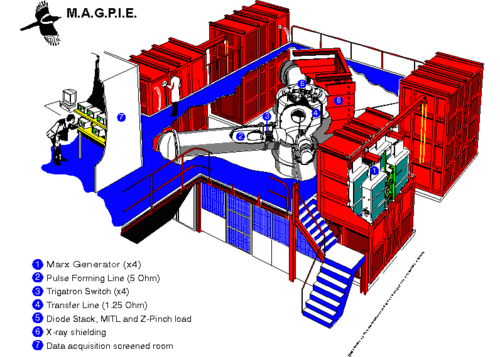
Drawing of MAGPIE. This whole posts takes place inside (5).
Downstairs, my finger is still pressed to the button that started the whole experiment. It’s only been milliseconds, and ‘Firing!’ still hangs in the air: so little time has passed that the word is only a few metres away. Four huge banks of capacitors have discharged a pulse of electricity which has been compressed in time and focused in space, rushing upwards through a squat cylindrical pipe filled with water towards the metal chamber held in a powerful vacuum.
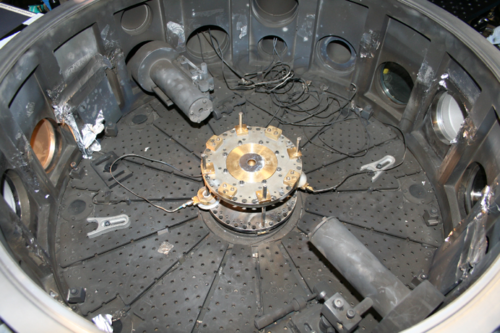
<;/div>
The chamber, a metal cylinder 80 cm across, shown here without the lid that seals it and allows us to pump all of the air out. The load is in the centre – the very small central circle is the diameter of the circle of pencil leads.
Inside the chamber, the valve has slammed shut, sealing the chamber closed, but it’s peaceful, with no sign of what’s to come – the electrical pulse is moving upwards at the speed of light, and there’s nothing that can go faster to warn of the powerful force approaching.
At the neck of the MITL, the narrowest gap between the inner cylinder and the outer, straining at the limits of its design, electrons flung across and whipped around and back, the current pulse enters through a slender stalk a few centimetres across. The metal surfaces heat, blowing off grease and oil in puffs of bright plasma, scouring our fingerprints from the tarnished metal and leaving a seething, roiling plasma around the cathode.
The current continues upwards, searching for a path back to the Earth, electrons driven onwards by the relentless, rising voltage. Above the cathode are eight carbon rods, the thinnest pencil leads you can buy, standing upright, arranged like a stone circle.
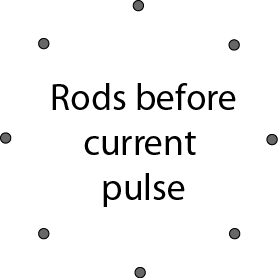
The electric current surges up through them, electrons colliding with the atoms in their graphite lattice, smashing them from their rightful places, joggling and jostling the atoms as the temperature rises and then the lattice can’t hold back, there’s a crack and an explosion, electric and elemental, the rods no longer solid, but liquid and vapour, expanding slothfully into the vacuum [1].
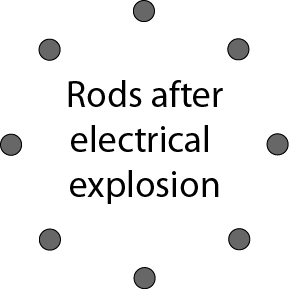
The electrons are flummoxed and in flux, their easy path destroyed by their own unstoppable eagerness, and now they find it far harder to push through the liquid core, so they head to the surface, the outside of the carbon columns, smashing into atoms along the way and liberating more electrons for the mayhem. The outside of the expanding-vapour-cloud-that-was-once-a-solid-carbon-rod heats and becomes a plasma, glowing, twisting, flowing, conducting and hence current carrying, a soup of electrons and ions in which the electrons can flow freely, electromagnetically active and still following the voltage wave dragging them upwards. This plasma is a corona, a seething crown surrounding the cold vapour-liquid core. [2]
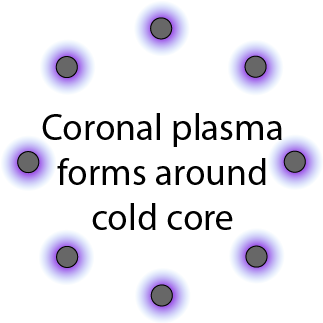
An electric current always generates a magnetic field, and each of the eight rods is encircled by rings of field lines, pushing the plasma back inwards and pinching it down. As the electric current increases, the plasma gets hotter, and its own pressure builds, pushing back against the magnetic prison until it can break free, and the plasma makes a dash for it towards the centre of the circle of rods.
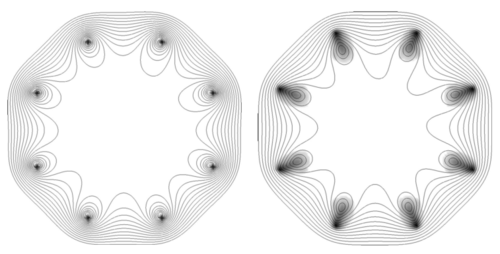
2D simulations of eight-wire arrays , showing magnetic field lines being dragged inwards by the plasma (right frame is later in time than the left frame) Shading is mass density [3].
Back at the rods, the hot plasma surrounding the cold cores is constantly renewed by wayward electrons stumbling into the liquid-vapour mix and ionising a stray atom here and there, a new recruit for the plasma corona that constantly flow inwards like smoke blown from a fire.
Dragging electric current along as it flows, the plasma shifts and changes the magnetic field, opening up the tight circles of field around each rod and morphing it so that more plasma is thrust inwards, accelerated up to massive speeds and hurled towards the centre. Right there, on the axis, eight streams of supersonic plasma meet and collide. [3]
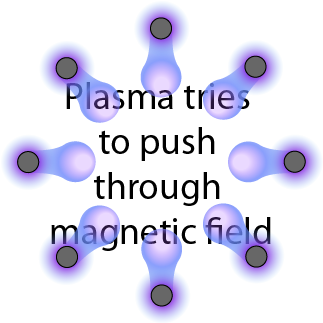
In the centre, a maelstrom of seething turbulent plasma has developed where the eight streams have collided and mixed, forming a shock that slowly expands outwards, a glowing pillar with a rippling surface, taking the speedy plasma and slowing it, exchanging velocity for temperature, compressing the plasma back to a high density so that it glows like a poker in a fire.
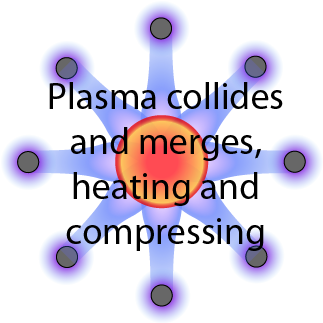
There’s precarious balance of heating and cooling here, like leaving a window open with the central heating on – the shock takes the fast plasma and makes it into hot plasma, creating a constantly renewed hot skin to the central column. The plasma loses heat by giving off light, not in the infra-red like animals do, but it’s so hot that the plasma glows with x-rays and ultraviolet light. Too much cooling and the column will collapse, unable to withstand the barrage from the new plasma hit its surface [4]. For now, the balance is just right and our column of plasma glows and grows, giving off invisible light that is captured by our cameras.
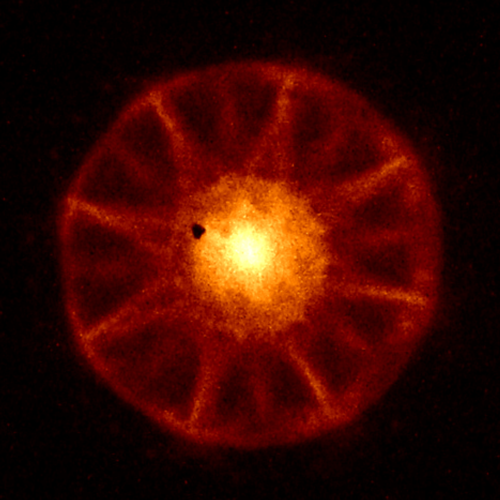
An extreme ultra-violet (XUV) image of the plasma. Just like an infra-red camera can see light invisible to the human eye, so can out XUV camera, which show not only the eight jets of plasma colliding with the bright central column, but eight additional spokes between the jets, hinting at additional standing shocks.
A delay circuit downstairs has been waiting patiently for its big moment, and here it comes – with a pulse of light, it signals a laser above it to fire, streaking the chamber with bright green light that distorts and deflects as it passes through the plasma on its way to a camera. The laser pulse is short, and the plasma barely moves in the billionth of a second it takes to pass, leaving a bright green snapshot of a single instant in time.
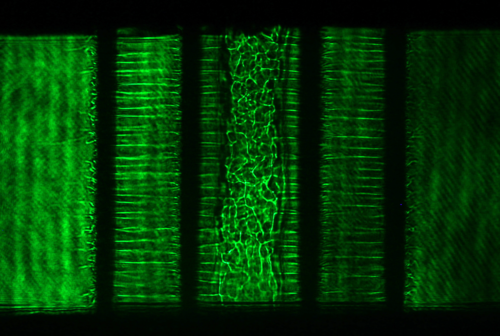
Laser shadowgraphy, this time from the side. You can’t see all eight rods because each rod hides one behind it.
By now, the experiment is over. The surge of electrical current begins to abate, the delicate balance is lost and the glowing column of plasma dims and then winks out, the rods cool to a roiling carbon fog that drifts and coats the inside of the vacuum chamber, and downstairs we hear the sharp metallic bang that signifies that something has just happened.
It’ll be another few minutes of check oscilloscope screens and cameras before we know if anything worked, several months of analysis before we understand what’s going on and maybe a year before a paper can be published to let the world know what happened in those scant few billionths of a second here in our machine, a dream of a machine, nestled in a windowless basement two floors under the ground, the dark oil slowly churning as it settles down after its brief exertion.
[1] Aleksandrov, V. V, et al. (2001). Dynamics of Heterogeneous Liners. Plasma Physics Reports, 27(2), 89–109.
[2] Lebedev, S. V et al. (2001). Plasma formation and the implosion phase of wire array z -pinch experiments. Laser and Particle Beams, 19, 355–376.
[3] Martin, M. R. et al. 2010). The role of magnetic field in the transition to streaming ablation in wire arrays. Physics of Plasmas, 17(5), 052706. doi:10.1063/1.3392288
[4] Bott, S. C. et al. (2009). Study of the effect of current rise time on the formation of the precursor column in cylindrical wire array Z pinches at 1 MA. Physics of Plasmas, 16(7), 072701. doi:10.1063/1.3159864